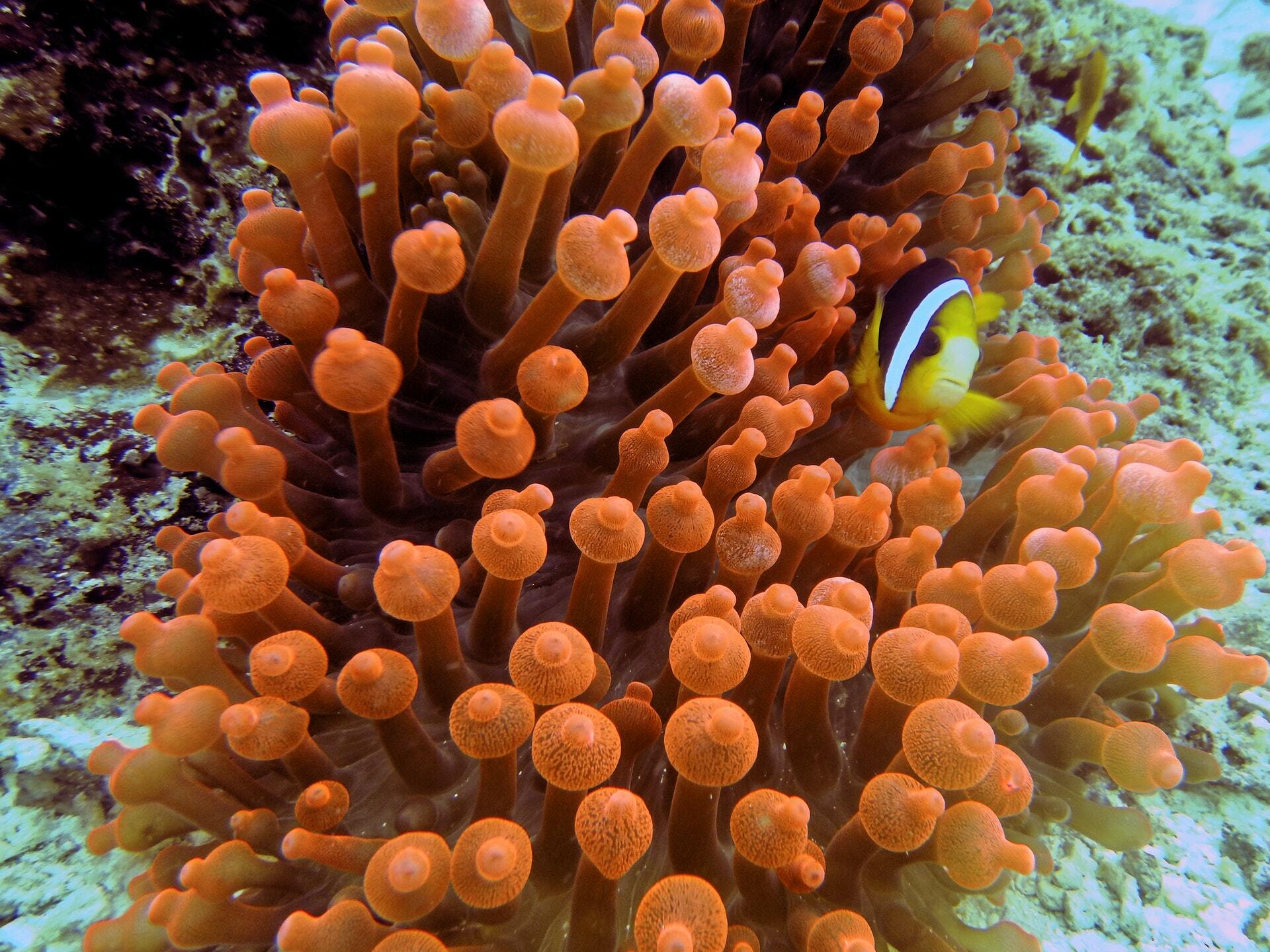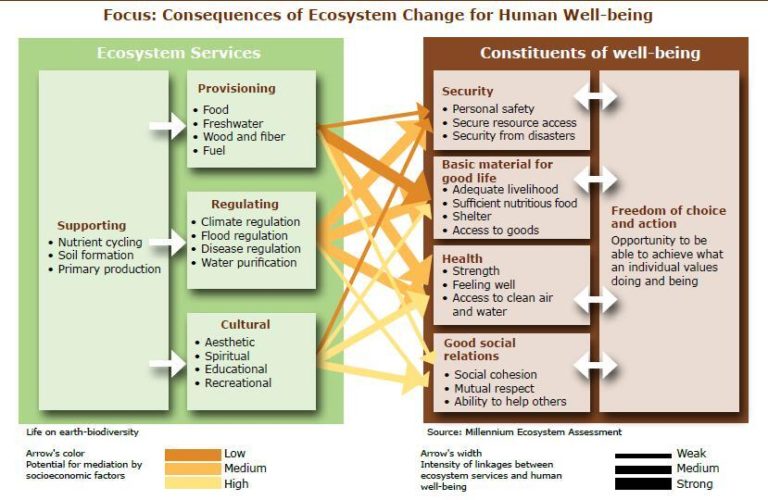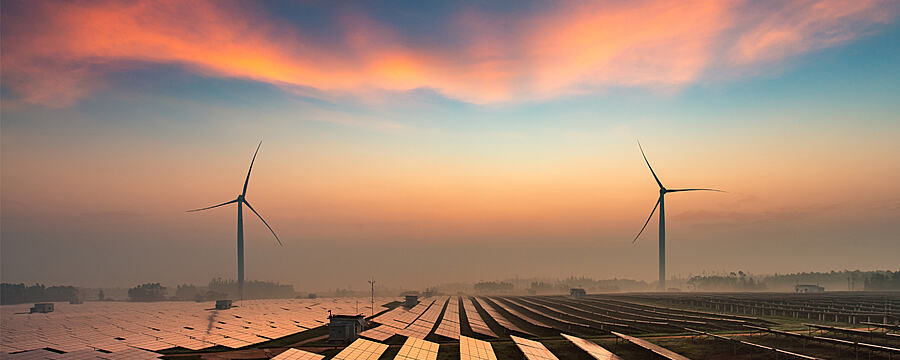Nature as a first line of defence

Share this step
Ecosystems are defined as “a dynamic complex of plant, animal and micro-organism communities and their non-living environment interacting as a functional unit” (Convention on Biological Diversity, 1992). They are a community of living and non-living things, of which humans are fully part.
In many cases ecosystems are mankind’s first line of defence against extreme events, such as floods, droughts, heatwaves, tropical storms and other effects of climate change. At the same time, ecosystems themselves are already being impacted by climate change, affecting their functions and the many benefits and services they provide. For example, rising ocean temperatures threaten sensitive biodiversity existing on the ocean floor.
Ecosystems play an important role in both adaptation and mitigation (Ojea, 2014). Adaptation action using nature-based solutions is crucial to minimize adverse outcomes from climate change for both ecosystems and society (GCA, 2019).
Ecosystem services
Ecosystem services are the benefits people obtain from ecosystems. Those services can be divided in provisioning, regulating and cultural services that directly affect people. Finally, there are supporting services that are needed to maintain the other services. An explanation of each category is as follows:
- Provisioning services: these are the products obtained from ecosystems, such as food, water, timber and fibre;
- Regulating services: these are the benefits obtained from the regulation of ecosystem processes that have an impact on climate, floods, diseases, waste and water quality and pollination. — Climate regulation aims to regulate processes related to the chemical composition of the atmosphere, the greenhouse effect, the ozone layer, precipitation, air quality, and moderation of temperature and weather patterns. — Disease regulation relates to the ability of healthy ecosystems to control the presence and spreading of insect, animal pests and human diseases. — Pollination relates to the transfer of pollen to plants/crops through bees, wasps, flies, etc.
- Cultural services: these are the nonmaterial benefits people obtain from ecosystems that provide recreational, aesthetic, spiritual and educational advantages;
- Supporting services are those that are necessary for the production of all other ecosystem services such as soil formation, photosynthesis and nutrient cycling.
Linkages between ecosystem services and human well-being
There are clear linkages between ecosystem services and human well-being, as depicted in the figure below.

Ecosystem based Adaptation (EbA) Briefing Note 2, Navigating the Adaptation Challenge. Source: UNEP.
(Click to expand)
As you can see, humans directly depend on ecosystems and their services for their well-being. The figure above shows how the four ecosystem services, in different and complex ways, have an impact on human well-being. The width of the arrows indicates the intensity of the linkages between ecosystem services and well-being.
Impacts of climate change on ecosystem services
We have already explored the impact of climate change on society in Week 1. Now, let’s examine the impact of climate change on ecosystems and the services they provide. Climate change affects ecosystems through its impacts on biodiversity. Biodiversity is also a key component of ecosystems. Biodiversity is defined as the variability among living organisms from all sources, including inter alia, terrestrial, marine and other aquatic ecosystems and the ecological complexes of which they are part.
When biodiversity is negatively affected by a changing climate, the ability of ecosystems to recover from shocks and stresses is also affected. Observed changes in climate have already adversely impacted certain species and further changes in biodiversity will be inevitable as climate change proceeds. The direct impact of climate change on biodiversity include:
- changes in ecosystem processes, such as changes in water catchment processes.
- changes in the timing of events in the natural world, which may lead to loss of synchronicity between species, for instance, with insect pollinators emerging at a different time to plants flowering.
- changes in species abundance and distribution, including the arrival of new species if conditions become more favourable and the loss of species that can no longer survive in these new conditions.
- changes in the composition of plant and/or animal communities due to man-made environmental changes such as acid rain or habitat destruction. These limit the natural migration of plant and animal species.
Changing habitat and extinction
A meta-analysis (Timmer, 2011) looking at 1300 different species, showed that climate change is already causing species to change habitat two to three times faster than expected. In Europe and North America, species are heading northwards and to higher ground over the last decades.
The 2019 report from the Intergovernmental Science-Policy Platform on Biodiversity and Ecosystem Services (IPBES) states that around 1 million animal and plant species are now threatened with extinction, many within decades, more than ever before in human history.
The average abundance of native species in most major land-based habitats has fallen by at least 20%, mostly since 1900. More than 40% of amphibian species, almost 33% of reef forming corals and more than a third of all marine mammals are threatened. Negative trends in nature will continue to 2050 and beyond in all of the policy scenarios explored in the Report, except those that include transformative change. Ecosystem loss and degradation as a result of population pressure, resource overuse and pollution, is already happening at an alarming rate. More than 35% of the world’s mangroves have disappeared. The figure is as high as 50% in countries such as India, the Philippines, and Vietnam. The tropics lost 12 million hectares of tree cover in 2018. Of greatest concern is the disappearance of 3.6 million hectares of primary rainforest, an area the size of Belgium.
Resilient to climate change
Ecosystems are more resilient to climate change if they are healthy and not affected by non-climate stressors such as pollution, ecosystem destruction and/or the overuse of natural resources. Ecosystems have limits beyond which they can no longer function and cannot provide the services on which communities and their livelihoods depend.
This loss and degradation are further exacerbated by the impact of a changing climate on already vulnerable ecosystems. It is therefore important that natural resource management and climate adaptation are mutually reinforcing and that adaptation strategies apply a “do no harm” approach to ecosystems and, where possible, reduce non-climate stressors.
Your experiences
Think of an ecosystem in your country. What species have been identified as endangered by climate change? Please share with other learners in the discussion below.
References
Convention on Biological Diversity UN 1992
Elena Ojea, Ecosystem-Based Adaptation, in: Handbook of the Economics of Climate Change Adaptation, Anil Markandya, Ibon Galarraga, Elisa Sainz de Murieta (eds.). Routledge, 2014.
Global Commission on Adaptation, Accelerating Adaptation: A Global Call to Action (2019), p. X.
Global Commission on Adaptation, Background paper on the Role of Natural Environment in Adaptation.
Global Forest Watch, The World Lost a Belgium-sized Area of Primary Rainforests Last Year
Hansen, L., Biringer, J.L and Hofmann, J (eds.). Buying Time: a user’s manual to building resistance and resilience to climate change in natural systems, World Wildlife Fund, 2003.
Intergovernmental Science-Policy Platform on Biodiversity and Ecosystem Services (IPBES), 2019, Summary for Policy Makers, April-May 2019.
IPBES Media Release, Nature’s Dangerous Decline ‘Unprecedented’; Species Extinction Rates ‘Accelerating’
IUCN, Nature-based Solutions to address global societal challenges, eds. E Cohen-Shacham, G Walters, C Janzen, S Maginnis, 2016.
Helen Jeans, Judy Oglethorpe, Joanna Phillips and Hannah Reid, The role of ecosystems in climate change adaptation, in: Community-Based Adaptation to Climate Change, Scaling it up, Routledge/Earthscan, 2014, London/New York, pp. 253-255.
John Timmer, 2011, Climate change causing species to change habitat faster than expected.
UNEP, Navigating the adaptation challenge
United States Environmental Protection Agency, Climate Impacts on Ecosystems
World Wildlife Fund, Mangrove forests are one of the world’s most threatened tropical ecosystems
Share this
Making Climate Adaptation Happen: Governing Transformation Strategies for Climate Change

Making Climate Adaptation Happen: Governing Transformation Strategies for Climate Change


Reach your personal and professional goals
Unlock access to hundreds of expert online courses and degrees from top universities and educators to gain accredited qualifications and professional CV-building certificates.
Join over 18 million learners to launch, switch or build upon your career, all at your own pace, across a wide range of topic areas.
Register to receive updates
-
Create an account to receive our newsletter, course recommendations and promotions.
Register for free







